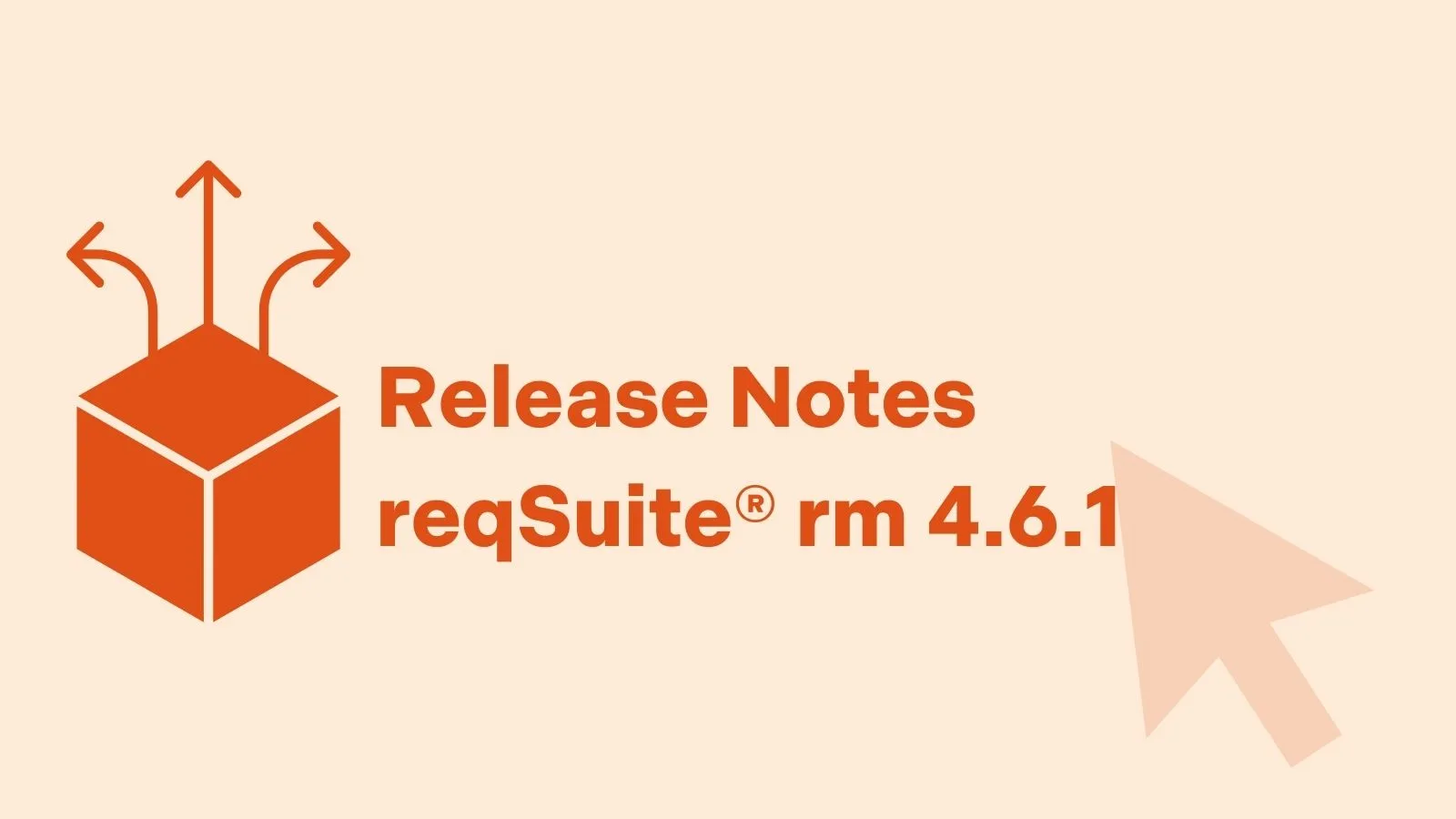
The best requirements management you've ever had.
Intuitive to use
Reliable in results
Efficient in processes

Validation and Verification in the V-Model: How to Successfully Ensure Product Development
2024-11-27
12
minutes reading time

Quality assurance as a success factor
Quality assurance processes play an essential role in product development, especially in safety-critical areas such as the automotive industry, medical technology or aerospace. They serve to ensure the quality and functionality of a product not only after completion, but already during development. Defects that are detected at an early stage can therefore be rectified more cost-effectively and prevent expensive product recalls or safety-related risks during subsequent operation.
The V-model is a proven process model for the structured implementation of development and testing processes. It is one of the classic development models and is characterized by its systematic, sequential structure, which is represented in the form of a “V”. The left-hand side of the “V” stands for the development phases, starting with requirements analysis, through system and software architecture to implementation. The right-hand side shows the corresponding test and inspection processes, which ensure that each development phase is comprehensively checked.
A central component of the V-model is therefore the consistent safeguarding of each phase through suitable test procedures. Two terms are particularly important here, but are often confused: Validation and verification. Although they both aim to ensure a high-quality product, they differ in terms of the questions they address:
- Validation (“Are we building the right product?”): This process ensures that the developed product actually meets the needs and expectations of the users. This is not just about the technical requirements, but also about practical applicability and added value for the customer.
- Verification (“Are we building the product correctly?”): This step checks whether the product has been developed exactly according to the specified requirements and technical specifications. Design, implementation and functionality are systematically checked using defined criteria.
The clear distinction between these two terms is crucial for effective quality management and helps companies to design development processes efficiently and minimize potential risks at an early stage.
It all depends on the requirements
Before the actual development along the V-model begins and the resulting artifacts are systematically validated and verified, a crucial foundation must be created: the validation of the requirements.
Because even the best development process cannot prevent errors if the underlying requirements are incorrect, incomplete or misleading. Requirements are the foundation of every development project. Errors at this early stage therefore have a domino effect on all subsequent phases.
However, a common mistake in practice is to simply accept requirements as given without critically scrutinizing their quality. There are various techniques to ensure that requirements meet the necessary quality criteria. One proven method is requirements inspection, in which requirements are systematically checked before they are incorporated into the development process. They are examined for key aspects such as completeness, clarity, consistency and correctness. Furthermore, a traceability analysis can help to identify gaps in the specification and ensure that each requirement has a concrete origin and a clear objective.
Without such early validation, there is a risk that incorrect or inadequate requirements will flow unnoticed into the development process. This can have serious consequences: Developers and designers design solutions based on false assumptions, which in the worst case can lead to it only being recognized in the final acceptance tests that the product does not meet the actual needs of the users. The consequences are not only costly rework, but also potential project delays and customer dissatisfaction.
Consistent validation of the requirements at the start of the project ensures that all subsequent development phases are based on a reliable and precise foundation. This significantly reduces the risk of undesirable developments and unnecessary rework. Structured requirements management therefore makes a decisive contribution to the efficiency and quality of the entire product development process and enables the V-model to be implemented smoothly.
Implement refinements correctly
Once the requirements have been successfully validated, the next crucial step in the development process begins: the gradual refinement of the requirements through to implementation. This process ensures that abstract customer requirements are not only converted into detailed technical specifications, but also translated into concrete system architectures and implementation decisions. Refinement takes place iteratively and on several levels - from the overarching customer requirements to rough architectural drafts and detailed design and implementation specifications.
The challenge lies in the fact that each refinement must be derived consistently and comprehensibly from the previous stage. This involves not only the precise definition of individual requirements, but also the design and implementation of suitable solution strategies. For example, a general customer requirement for an “intuitive user interface” can first be translated into functional requirements for navigation and interaction. These are then translated into concrete UI designs and finally into code.
Missing or incorrect derivations can have serious consequences: If requirements are not clearly translated into solution architectures, there is a risk that developers will use scope for interpretation that does not match the actual objectives. Incorrect technical implementation can also lead to the desired functionality being defined on paper but not being implemented correctly in practice. Such errors are particularly critical as they affect the entire development process and cause high rework costs later on.
Structured checks should be carried out to ensure that the refinement is implemented correctly at both requirements level and solution level. This includes methods such as:
- Reviews: Experts review not only the requirements, but also architecture decisions, design specifications and implementation details to ensure that all derivations are correct and consistent.
- Simulations and prototypes: Early modeling, mock-ups or simulations help to verify that the chosen solution concepts fulfill the desired functions and are practicable.
- Traceability analyses: End-to-end traceability between requirements, design decisions and code ensures that all system components remain aligned with the original objectives.
The refinement of requirements, solution concepts and implementations is a continuous, iterative process that must be accompanied throughout the entire development cycle. Only if each refinement stage is clearly defined, checked and correctly documented can it be ensured that not only the “right product” is developed, but that it is also implemented “correctly”. This creates a solid foundation for efficient, error-free and targeted product development.
Tests as an integral part
Parallel to the step-by-step refinement of requirements, solution concepts and implementations, an equally important process takes place: the systematic definition and linking of test cases with the various development artifacts. The V-model stipulates that suitable test procedures are defined for each refinement level to ensure that each implementation stage is not only technically correct, but also functionally meaningful. This ensures that errors can be detected and rectified at an early stage before they propagate to later phases and cause high costs there.
The test strategy is based on the various levels of refinement and comprises several types of tests:
- Customer requirements → Acceptance tests: These tests check whether the developed system fully meets the actual customer requirements. The focus here is on functional requirements and user-friendliness. Acceptance tests are often carried out together with customers or end users to ensure that the product delivers the expected added value in practice.
- System and solution designs → Integration tests: At this level, the interactions between the individual system components are tested. Integration tests ensure that different modules or subsystems work together correctly and that no unexpected interface problems or incompatibilities occur.
- Implementation modules → Unit tests: This involves the detailed testing of individual modules or components. Unit tests ensure that the smallest functional units work as intended and reliably fulfill defined requirements. They are particularly valuable as they uncover errors in the implementation at an early stage and enable quick corrections to be made.
A central principle here is consistent test alignment with the requirements. This means that each test case must be assigned to a specific requirement so that it can be seamlessly traced whether a developed function actually does what was originally specified. This traceability is essential to ensure that no requirements remain untested and that no unnecessary functions are developed that do not match the original objectives.
A particularly critical aspect of this process is the continuous adaptation of test cases as requirements change. In real projects, changes are inevitable - be it due to new customer requests, regulatory adjustments or technical findings during development. To ensure that the test strategy remains reliable, test cases must be reviewed and adapted immediately whenever a relevant change occurs. Otherwise, there is a risk that test cases will become obsolete, lose their validity or even deliver incorrect results.
Implement validation and verification effectively
A structured approach is required to ensure efficient validation and verification in the development process. Only clear processes and consistent implementation can ensure that the developed product meets both the original requirements and the actual customer needs. Transparency, traceability and a close interlinking of requirements, refinements and test procedures play a central role here.
The following are the most important aspects that should be considered for a successful validation and verification process:
1. Clear definition of requirements
Sound validation and verification begins with clearly defined and precisely documented requirements. Each requirement should be formulated in a complete, consistent and testable manner in order to avoid misunderstandings and room for interpretation later on. An imprecise requirement can lead to tests failing, being inconclusive or unnecessary rework. Methods such as structured reviews, checklists or standardized templates for requirements help to ensure their quality.
2. Link between requirements and tests
A fundamental principle of an effective validation and verification process is traceability between requirements and test cases. Each requirement should have at least one associated test case that checks whether the specification has been implemented correctly. This ensures that all relevant requirements are actually tested and that no essential aspects are overlooked or misinterpreted.
Consistently implemented traceability management makes it possible to trace which tests belong to which requirements and vice versa at any time. This not only helps with error analysis, but is also essential for regulatory requirements, for example in medical technology or the automotive industry.
3. Continuous review of the refinements
As requirements are gradually transformed into solution designs, architectures and implementations during the course of development, it is essential to continuously review these refinements. Each derivation must be logically comprehensible and correctly derived from the previous level. Inconsistencies or unclean transfers can lead to the developed system no longer matching the original requirements.
Methods such as reviews, modeling, simulations or prototyping are used here to identify and correct potential deviations at an early stage. In this way, errors can be avoided at an early stage before they become a feature of the entire development process.
4. Efficient management of requirement changes
In almost every development project, changes to requirements are unavoidable - be it due to new customer requirements, legal adjustments or technical findings during development. It is crucial that such changes are managed in a controlled and comprehensible manner.
Effective change management includes:
- The complete documentation of every change in requirements.
- Analyzing the impact on existing requirements, refinements and test cases.
- Immediately adapting affected tests to ensure that the changed requirements continue to be checked.
Well-organized change management maintains consistency between development artifacts and ensures that new or changed requirements are correctly implemented and validated.
Validation and verification with RM tools
The validation and verification processes described above illustrate how essential a structured and systematic approach is for successful product development. Manual or unstructured methods quickly reach their limits, especially in complex development projects in which numerous requirements have to be defined, worked out in detail and linked to corresponding test cases. Incorrect or incomplete requirements, a lack of traceability between requirements and test cases or unclear effects of changes can lead to serious problems in the development process.
To meet these challenges efficiently, specialized requirements management tools are available to help companies not only manage requirements systematically, but also integrate the entire validation and verification process seamlessly.
reqSuite® rm is a modern and powerful requirements management tool specifically designed to help organizations define, manage and track requirements. With its intelligent automation, flexible configurability and user-friendly interface, reqSuite® rm helps to efficiently and reliably implement validation and verification processes within the V-model.
To ensure that requirements are not only defined completely and correctly, but can also be consistently linked to tests and tracked, reqSuite® rm offers a range of powerful functions:
- Automatic requirements checks: One of the biggest challenges in requirements management is the quality assurance of the requirements themselves. reqSuite® rm analyzes requirements for ambiguities, contradictions or missing information as soon as they are entered and provides automatic suggestions for improvement. This makes validation much easier and minimizes the risk of misinterpretations or gaps.
- Seamless traceability and linking with test cases: A central element of verification is traceability, i.e., the traceability between requirements and tests. With reqSuite® rm, all requirements can be linked directly to the corresponding test cases (e.g., acceptance, integration or unit tests). This ensures that each requirement is checked by at least one test case and that no requirement remains untested.
- Impact analysis for changes: Changes to requirements are unavoidable in practice, but they carry the risk of affecting existing specifications, refinements and tests. reqSuite® rm automatically analyzes the impact of changes and shows which downstream artifacts are affected. This ensures the consistency of the entire development and prevents unexpected gaps or inconsistencies.
- Assistance with the refinement of requirements and solution concepts: Systematic refinement of requirements, designs and implementations is essential for ensuring clear, consistent development processes. reqSuite® rm provides structured templates, input aids and guidelines to ensure that refinements are carried out in an orderly, comprehensible and consistent manner. This maintains the link between abstract customer requirements and concrete technical specifications.
- Seamless integration into the development process: Validation and verification are only truly effective if they are continuously and efficiently integrated into the overall development process. reqSuite® rm enables smooth collaboration between requirements managers, developers and testers by adapting flexibly to existing development and test environments. Validation and verification are not treated as a downstream step, but are embedded in the process from the very beginning.
With reqSuite® rm, validation and verification processes in requirements management can be sustainably improved. The automated testing mechanisms, end-to-end traceability, structured support for refinements and intelligent change analysis help companies to detect errors at an early stage, control test processes efficiently and significantly reduce development costs.
Clear structures
Validation and verification are essential components of a successful development process, especially in safety-critical areas. The V-model provides a clear structure for systematically checking requirements, making correct refinements and validating these through specific tests. The early validation of requirements is crucial to ensure that the right solutions are developed right from the start. It is equally important to continuously check whether all refinements and tests have been correctly derived from the higher level in order to avoid errors and ensure traceability.
A modern requirements management tool such as reqSuite® rm ideally supports these processes by systematically recording requirements, automatically checking their quality and enabling a seamless link to test cases. The integrated impact analysis also ensures that no important steps are overlooked when changes are made.
Companies that use reqSuite® rm benefit from a more efficient, transparent and error-free implementation of their validation and verification processes. With the right methods and tools, you not only create the basis for high-quality products, but also ensure the long-term success of your projects. Use these synergies to take your product development to the next level.
About the author

Murat Polat
Chief Engineer
Murat Polat has been with OSSENO Software GmbH for nearly four years, playing a key role in the further development of reqSuite® rm as Chief Engineer. With his expertise in software architecture and system development, he ensures that the software remains technologically up-to-date and integrates seamlessly into users’ workflows. His focus is on creating stable, high-performance, and user-friendly solutions that meet the needs of modern businesses.
Other interesting articles

Tips
10
minutes reading time
The 12 Most Important Things You Should Know About Requirements Management Tools

Dr. Sebastian Adam
2025-02-12

Knowledge
8
minutes reading time
Clear Requirements, Satisfied Stakeholders: How Projects Succeed

Johanna Lotter
2025-01-17

Tech
5
minutes reading time
What Makes reqSuite® rm so Special...

Dr. Sebastian Adam
2023-12-07

Tech
3
min. reading time
reqSuite® rm – Interface to Isograph RWB & AttackTree

Neele Borkowsky
2025-12-10

Knowledge
10
min. reading time
Requirements Management Tools 2026: A Comparison for Medium Sized Product Developers

Neele Borkowsky
2025-12-08

Tech
5
min. reading time
Release Notes reqSuite® rm 4.6.1

Phil Stüpfert
2025-12-07











